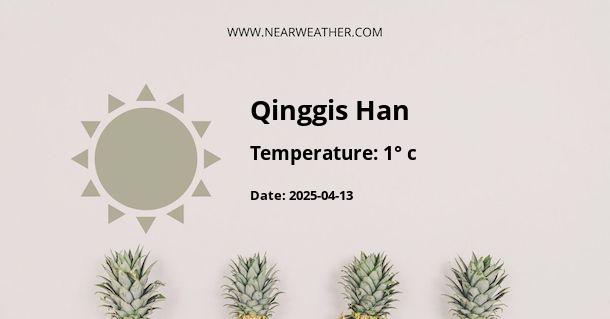The Climate and Weather of Qinggis Han, China
Qinggis Han, located in the Inner Mongolia Autonomous Region of China, experiences a unique climate characterized by extreme temperatures and arid conditions. The region is known for its vast grasslands, deserts, and steppe landscapes. Understanding the climate and weather patterns of Qinggis Han is essential for residents, tourists, and those interested in studying the region's environment. Let's explore the climate and weather of Qinggis Han throughout the year.
1. Temperature
The temperature in Qinggis Han can vary significantly between seasons and even within a single day. The region has a continental climate, which means it experiences hot summers and cold winters.
During the summer months of June to August, Qinggis Han sees average high temperatures ranging from 25°C (77°F) to 30°C (86°F). However, temperatures can occasionally reach as high as 35°C (95°F) during heatwaves. Nights are generally cooler, with average lows between 10°C (50°F) and 15°C (59°F).
In contrast, winter in Qinggis Han is harsh and bitterly cold. From December to February, average high temperatures range from -10°C (14°F) to -5°C (23°F), with lows dropping to -20°C (-4°F) or even lower. It's not uncommon for the region to experience strong winds and heavy snowfall during the winter months.
Spring and autumn serve as transitional seasons, with temperatures gradually warming up or cooling down. Spring, from March to May, sees average highs between 10°C (50°F) and 20°C (68°F), while autumn, from September to November, experiences highs ranging from 15°C (59°F) to 25°C (77°F).
2. Precipitation
Qinggis Han has a relatively low annual precipitation, with most of it occurring during the summer months. The region is classified as having a semi-arid climate, meaning it receives limited rainfall.
During the summer, Qinggis Han receives most of its precipitation, with June being the wettest month. The average monthly rainfall during this period ranges from 50mm (1.97 inches) to 80mm (3.15 inches). However, it's important to note that rainfall is sporadic and often concentrated in short, intense thunderstorms.
Winter is the driest season, with very little rainfall or snowfall. The annual precipitation in Qinggis Han is typically around 200mm (7.87 inches) to 300mm (11.81 inches), making it a relatively arid region.
3. Wind and Duststorms
Qinggis Han is known for its strong winds, which can contribute to the formation of duststorms. The region experiences frequent gusts of wind throughout the year, especially during the spring months.
From February to April, Qinggis Han is prone to duststorms, which can result in reduced visibility and cause respiratory issues. These storms are caused by the combination of dry conditions, strong winds, and the presence of loose soil and sand in the surrounding areas.
4. Sunshine Hours
Qinggis Han enjoys a significant amount of sunshine throughout the year. The region experiences around 2,800 to 3,000 hours of sunshine annually, with an average of 7 to 8 hours per day.
Summer months tend to have the highest number of sunshine hours, with clear skies and longer daylight. In contrast, winter months have shorter daylight hours and fewer sunshine hours, although the sunshine can still be intense even in cold temperatures.
5. Climate Adaptation
The extreme climate of Qinggis Han presents challenges for both human and animal inhabitants. The local population has adapted to the conditions over generations, with traditional nomadic lifestyles and practices that allow them to cope with the harsh environment.
For tourists visiting Qinggis Han, it's important to prepare accordingly. During the summer, lightweight and breathable clothing is recommended, along with sun protection such as hats and sunscreen. In winter, layering clothing and wearing insulating materials is crucial to stay warm in freezing temperatures.
Additionally, staying hydrated is crucial in Qinggis Han's arid climate, so carrying water bottles and regularly drinking fluids is essential.
Conclusion
Qinggis Han's climate is characterized by extreme temperatures, aridity, and occasional duststorms. The region experiences hot summers with temperatures ranging from 25°C (77°F) to 30°C (86°F) and cold winters with temperatures dropping as low as -20°C (-4°F). Precipitation is limited, with most rainfall occurring during the summer months, and the region enjoys a high number of sunshine hours throughout the year.
Understanding the climate and weather patterns of Qinggis Han is essential for residents, tourists, and researchers studying the region. By being prepared and adapting to the unique climate, individuals can fully experience and appreciate the beauty and challenges of this remarkable part of China.
A - Qinggis Han's Latitude is 47.750000 & Longitude is 122.833328.
A - Weather in Qinggis Han is 1° today.
A - Climate Conditions in Qinggis Han shows light snow today.
A - Humidity in Qinggis Han is 97% today.
A - Wind speed in Qinggis Han is 37.04 km/h, flowing at 13° wind direction. today.
